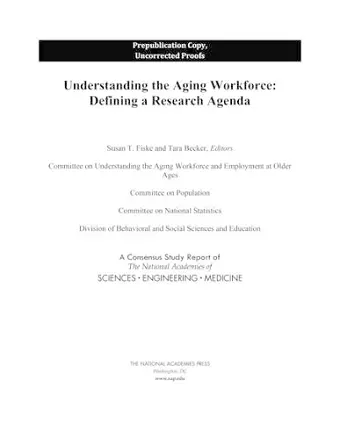Understanding the Aging Workforce
Defining a Research Agenda
Committee on National Statistics author Division of Behavioral and Social Sciences and Education author Committee on Population author National Academies of Sciences, Engineering, and Medicine author Committee on Understanding the Aging Workforce and Employment at Older Ages author Tara Becker editor Susan T Fiske editor
Format:Paperback
Publisher:National Academies Press
Published:21st Jan '23
Currently unavailable, and unfortunately no date known when it will be back

The aging population of the United States has significant implications for the workforce - challenging what it means to work and to retire in the U.S. In fact, by 2030, one-fifth of the population will be over age 65. This shift has significant repercussions for the economy and key social programs. Due to medical advancements and public health improvements, recent cohorts of older adults have experienced better health and increasing longevity compared to earlier cohorts. These improvements in health enable many older adults to extend their working lives. While higher labor market participation from this older workforce could soften the potential negative impacts of the aging population over the long term on economic growth and the funding of Social Security and other social programs, these trends have also occurred amidst a complicating backdrop of widening economic and social inequality that has meant that the gains in health, improvements in mortality, and access to later-life employment have been distributed unequally.
Understanding the Aging Workforce: Defining a Research Agenda offers a multidisciplinary framework for conceptualizing pathways between work and nonwork at older ages. This report outlines a research agenda that highlights the need for a better understanding of the relationship between employers and older employees; how work and resource inequalities in later adulthood shape opportunities in later life; and the interface between work, health, and caregiving. The research agenda also identifies the need for research that addresses the role of workplaces in shaping work at older ages, including the role of workplace policies and practices and age discrimination in enabling or discouraging older workers to continue working or retire.
Table of Contents- Front Matter
- Summary
- 1 Introduction
- Part I
- 2 The Emerging Older Workforce
- 3 Work and Retirement Pathways
- Part II
- 4 Individual and Social Factors That Influence Employment and Retirement Transitions
- 5 Workplace and Job Factors
- 6 Age Discrimination, One Source of Inequality
- 7 The Labor Market for Older Workers
- 8 Public Policy
- Part III
- 9 A Research Agenda to Promote Understanding of Employment among Older Workers
- References
- Appendix A: Meeting Agendas
- Appendix B: Committee Biosketches <
ISBN: 9780309493871
Dimensions: unknown
Weight: unknown
280 pages